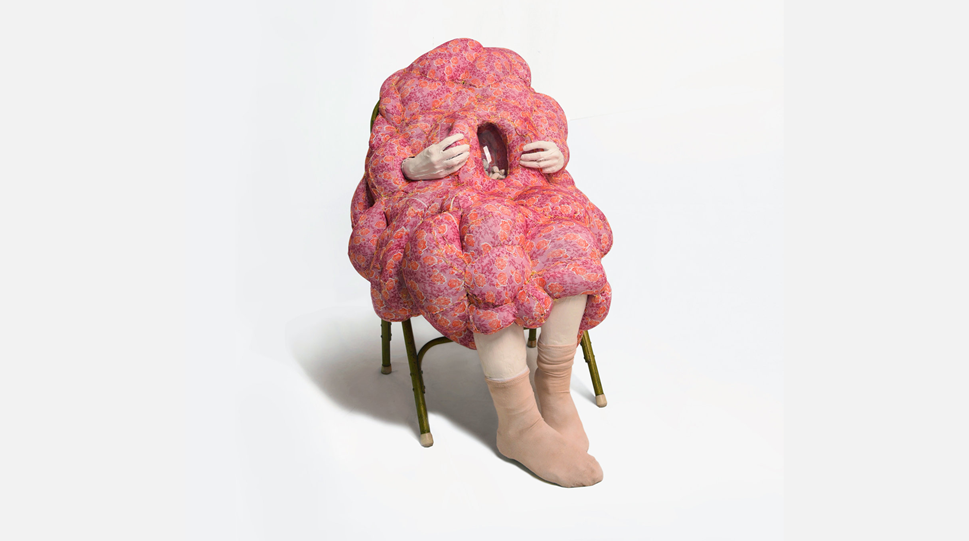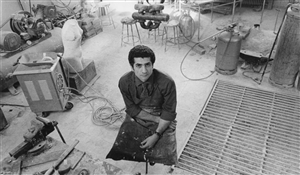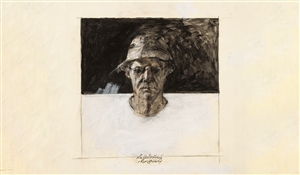Hoda Zarbaf; the Narrator of "Memory" and "Absence"
14 Aug 2022Original text in Farsi by Shamim Sabzevari
Translated to English by Sara Faezypour
"All my experiences or exercises of love, lust, melancholia, growth, and so on begin with and in my body. I would even go so far as to tell you that my art is an extension of my body and my physical existence."
Hoda Zarbaf (1982–2020) was a sculptor and multimedia artist in the field of conceptual art who focused more than anything on the notion of "memory", dealing with the lack of something that once existed, and belonged to someone, but now only its memory or abandoned body remains. Concentrating on nostalgic objects and items, she represented such absence and displayed the sense of remaining empty and irretrievable loss in the form of her sculptures and installations. For example, she would combine found objects with human and individual identity traces like a stitch: obvious and explicit. These items could consist of anything, ranging from colorful fabrics, used socks, and worn t-shirts to old and abaandoned furniture; from human hair and deserted dolls to homemade videos, retrieved screen monitors, recorded voices, and even youtube videos.
She was quite daring when it came to mixing materials, techniques, and media; however, what is prominent in her work lies in its narrative aspect. the Usage of literature next to visual elements plays a particular role in her artwork, being nothing but the creation of new stories by uniting those abandoned lifeless objects. She started her creative process by getting inspiration from the physicality of the random objects, which at the same time, carried the past tales and lived experiences of the people with them. This is where the brilliant feature of her work is highlighted. As she has said so herself,
"I like to think of myself as a storyteller rather than an 'artist'."

Hoda Zarbaf | My Grandma Is Waiting for Me | 2016
Hoda Zarbaf was born in Tehran. After receiving a high school diploma in Graphics, she entered the Faculty of Fine Arts at the University of Tehran in 2001 to study Painting. In 2005, she graduated from university and held her first solo show, "Before Birth Project" at the University of Tehran. In the same year, she did her masters in the field of Animation at Tehran University of Art and received her degree in 2008. She then moved to Canada to study Fine Arts at the University of Windsor in Ontario. In 2010, she completed her studies and put on her solo display, "[un]veiling", at Art LeBel Gallery in Windsor, Canada. During the 2010s, she featured her artwork in various group and solo shows in Canada, the USA, and Iran.
Zarbaf "narrated" through creating her artworks; meaning that by gathering those discarded, forgotten - and seemingly useless - household objects and combining them with different lights, sounds, videos, or fragmented elements, she attempted to present a contemporary narrative that extended from the past and stayed in our memories without losing its meaning. The uncanny and bizarre characters that she created were witnesses and representatives of basic and lasting human emotions that sometimes stem from lack, many of which correspond with the notion of the body and the experience of corporeality. As a female artist, having experienced life in two different countries and cultures, she sought to represent earnest and intimate narratives of the complicated endowments of being a woman, in addition to addressing the concept of loneliness.
In fact, what Zarbaf narrated was not detached from the experience of the body, especially the one attributed to women. This fundamental element was what shaped those sculptures and installations. The woman was always in the center, in solitude, having to confront a multitude of emotions: memory, pain, pleasure, sexual desires or compulsiveness, and inner complexes. She presented such women in various roles or states, who whether vulgar, in a motherly situation, or a fantastic character, were engaged in a vibrant act of liberating themselves. The display of such a process of feminine liberation and revelation was always attractive and enchanting for Zarbaf, saying,
"The woman's body specifically is a big source of my imagination. Beyond its representational beauty, I like the performative aspect of the feminal body. The exposures, discharges, and expressions mesmerize me. It gives out signaling scents and discharges, blood, and life itself: it creates and gives out another human's body. It is constantly creating and exposing."
This approach of Zarbaf is best manifested in the pieces of the "Soft Souls" show.

Hoda Zarbaf | "Soft Souls" | Walnut Contemporary Gallery | Toronto | 2015 | Curator: Sanam Samanian | Image courtesy of the artist's website | Photographer: Mehrdad Ahari
In 2015, she had the solo show, "Soft Souls", curated by Sanam Samanian, in Walnut Contemporary Gallery in Toronto. Similar to her other works, she used recycled textiles, old toys, and found objects to express her understanding of being a woman, representing traditional skills and tools associated with one.
Some of the pieces in the show were about the feminine process of liberation, revelation, and expression, be it the act of bearing children, the discharge of hormones, the expression of pain and joy, and even satisfaction and narcissism. In these works, Zarbaf made good use of colors and forms to represent her lived experience, having an inseparable bond with her body. The softness and movement of the filled fabrics in contrast with the stability and firmness of the chair, create a visual duality that could be a reflection of the bodily contradictions. The domination of warm and red colors, the jumping forms and shapes similar to a rainbow arc that balance the atmosphere, giving metaphorical meaning to it, have a special role in connecting the viewer to the work. Moreover, the representation of the shapes resembling homes in all the colored and patterned fabrics invoke the notion of inner peace and security. These contrasting elements persist throughout the work like disorderly stitches, creating unity yet negating perfection; a kind of multiple outpouring, numerous children, a fertile rainbow.
Other works by Zarbaf in the series include "the Mistress" and "Her Baby", dealing with issues of sexuality, pleasure, building a life, and chasing dreams. The titles chosen for the works make their atmosphere more internal and personal. As she stated herself, poetry and storytelling were of great inspiration for her, which can be appropriately seen in her process of titling the artworks. Using the metaphors common in the Farsi language – even ones used in conversations and daily chats between people – she tried to create visual metaphors; a balanced point between language and expression, corresponding to her experiences and practices:
"I am incredibly fascinated by words. I like sensual words, contradicting phrases, satirical compositions…. There are some words that are more visual than others, and the other ones that are solely abstract. I like the combination of them; similar to the process I mix and match my mediums to make sculptural figures and structures."
Instead of the intellectual discourse existing behind many artworks, here the emotions of the viewers get involved. Each person could have his or her account when faced with the pieces. As Zarbaf herself also desired:
"I often dread talking or writing about my work extensively, since it defines and translates the art in a way that limits the imagination and interpretations of the audience…. I like when my work connects people to themselves: to their memories, desires, and fears."

Hoda Zarbaf | "Floral Compositions: Travellers of Time" | Aaran Gallery | Curator: Sanam Samanian | 2016 | Image courtesy of the artist's website | Photographer: Masoud Abbasi
In 2016, Zarbaf held the solo show, "Floral Compositions: Travellers of Time", at Aaran Gallery. By combining, transforming, and connecting those used old junks, she created her sculptures. Like Zarbaf's other works, the essence of this series was materialized through a kind of inner conflict, both in form and meaning; there was a link between the contradicting meanings created by the duality of softness and hardness, old and new, organized and disorderly, as well as the connection between the past and present: the juxtaposition of hard and firm components like furniture and fabrics, or, basically, the huge contrast of how objects belonging to the past have gained meaning in the present.
After 9 years of residing in Canada, she built the pieces of this series upon her return to Iran, exploring her childhood memories, family relationships, and daily life. In addition, to create the sculptures, she used the remaining pieces of the family's past, such as clothes and household objects, and completed her narrative, using media, including video, sound, and light, granting another dimension to the work. This was where the title of the show made sense as she had made an effort to represent and narrate the notion of time, rather than place. In fact, by adopting what belonged to the past of her family and herself, instead of the concept of lack and memory, she represented it in the present, challenging this inner emotion.
In 2017, she presented the solo show, "We Are Image-making Machines", at Aaran Projects. One of the featured works in the collection was "Front Camera/Back Camera", displaying two drawings of her thoughts. This work revealed the state of Zarbaf's "self"-reflection by looking at her essence: a false projection, a conversation between the self as the mental intelligent "I" and the self as the "I" which is a known object and could play the role of the "other" as well.

Hoda Zarbaf | "We Are Image-making Machines" | Aaran Projects | Curator: Sanam Samanian | 2017 | Image courtesy of the artist's website | Photographer: Sajedeh Elhami and Danial Seyedin
In 2020, she put on a solo show, "Honey, I Am Home!", of her last work collection at Plus 2, a series of mixed-media installations, dealing introvertedly with the ever-present experience of "loneliness". As usual, she presented her inner study and representation of personal space through memories. Naturally, the covid pandemic had an impact on the formation and conceptualization of the series since the condition of this period redefined the concept of "domestic life", forcing everyone to some extent into inevitable isolation. The more familiar people's relationships with their homes were the more aware they became of how they lived in their environment and, of course, human's natural loneliness. This experience also turned into an endless and loop-like string of consumptive moments that are remembered, informing us about who we are and how we relate to our surroundings.
Through nostalgic elements, household objects, satirical content, wordplay, and altering the presentational and visual scales, Zarbaf also portrayed a layer of memory as well as her personal narrative of the present life in conjunction with the past. This installation focused on the issue of remembrance by adding a curious metanarrative, referring to itself as well as other pieces in the series. Together they depict a hyper-real living environment in which the boundaries of reality and imagination are deliberately blurred.

Hoda Zarbaf | "Honey, I Am Home!" | +2, 2020 | Image courtesy of +2
Over the years, Zarbaf's mixed-media and conceptual artworks traveled to cities such as Berlin, Hamburg, New York, and Vancouver, some of which were displayed in museums including AGO Toronto, and Tehran Museum of Contemporary Art. But, eventually, this creative and innovative artist passed away in her home in 2020, 9 days after her last solo show, "Honey, I am Home!". What an intriguing and moving narrative… the same obvious contradiction forming the inner essence of her work.
In most of her works, she paid attention to the nature of the objects to narrate wishes, pain, despair, and hope at the same time. Next to each other, Her fabric sculptures with entangled body parts, made up of trumperies, fabrics, and disposable found objects turned into one homogenous, eye-catching, and expressive object, which despite the large and stitch-like seams, different colors, and materials, affirm its incomplete and heterogeneous nature. The antique yet structured furniture, despite the fragility of its neighboring soft faces, creates a sense of stability and immortality. Even the bright colors constantly battling with the absurd and sarcastic state of the space are embodiments of the display of this dualistic and paradoxical layering. In these works, the individual and personal narrative is important: Zarbaf's narrative as the creator of the piece and the audience's narrative as its viewer and recipient.






